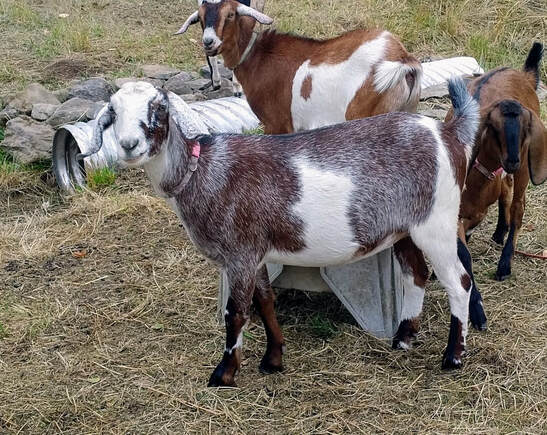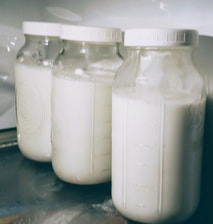|
Edited to update: IT WORKED! We had a confirmatory blood test. Chrissy is due sometime around May 19th!  Way back about Thanksgiving time, before Christmas, Winter Break and the New Year, we started a process of treating our doe Chrysanthemum who seemed to be having trouble conceiving. She had been bred multiple times and still kept cycling into heat again. I did a bunch of research, and based on my research, it seemed likely she had a condition goats can get called cystic ovaries. So I called the vet, and got some meds to treat this. Here is what we did. We waited until 5 days after her last heat, and then gave her a dose of 2mL of Lutalyse IM to restart her cycle from day one again, then 7 days later, gave her 2mL of Fertagyl IM (I have also seen people use 1mL, or Cystorelin which is a different brand of the same stuff). I wasn’t joking around, so I used the full recommended 2mL to lyse or break up all the cysts we were speculating may have been the culprit in keeping her from getting pregnant, then 7 days later gave her 2 mL of Lutalyse IM to restart her hormonal cycle again, then 3 days after that, she came into heat, we put her back with the buck and gave her another 2mL of Fertagyl IM (I have seen some protocols that recommend 1mL, then another 1mL 24 hr later. I did the whole amount all at once). This protocol is said to have around a 70% success rate, although some animals do not take until the heat following this treatment. It is January now, so I am not sure Chrysanthemum has another heat in her. In this area, most goats stop cycling in January or February, with just a few going until March. 28 days and counting later Chrysanthemum has not come back into heat again that we have seen. Next week after we pass the 30 day mark we will do a pregnancy test (UBRL advertises they can do pregnancy tests on goats as early as 30 days. I have not done one this early before, but in this case I will because I am an anxious farmer). Here is the protocol I used: Day 0 (5 days after last heat) 2mL Lutalyse IM (prostaglandin) Day 7 2mL Fertagyl IM (gonadorelin) Day 14 2mL Lutalyse IM Day 17 2mL Fertagyl IM 30 days after breeding (47 days after the start of this process) Blood Preg test  Now before everyone freaks out about the use of hormones in a animal that is destined to produce milk, I want to talk a tiny bit about what specifically each of these hormones do. They have a very short term job. There is no indication that humans should avoid milk or meat from animals treated with these drugs. As a matter of fact, the tests done on lutalyse indicate it does its job and is out of the body in minutes. Fertagyl also processes out of the body in a very short amount of time and there are no noted side effects from this hormone in the literature. In goats, technically, they ripen a new egg at what we humans consider the end of a cycle. During this time, the estrogen levels are dominant and eggs grow. These eggs mature in a fluid/jelly/mucus filled cyst or sack. This part of the cycle is actually really short, usually about 5 days. At the end of this time, the goat goes into heat, the pituitary gland produces a short burst of gonadorelin hormone, the follicle or the sack that the egg is growing in breaks open, releasing the egg to be fertilized. (this is considered the start of the cycle by humans, although by nature of it being a cycle, I don’t know if it actually has a start…) The gonadorelin also triggers the body to turn that follicle into something called a corpus luteum that produces progesterone to support a pregnancy, if pregnancy occurs. During that time, the goat’s body assumes it is pregnant because of the progesterone hormones being produced by the corpus luteum. As the cycle continues, if there are no implanting eggs, the body recognizes that implantation did not happen and releases a surge of the prostaglandin hormone that kills the corpus luteum, the progesterone level falls, the estrogen level increases, and the whole thing starts over again. In a goat with cystic ovaries, this system breaks down. Some speculate that it is increased fat around their organs keeps the eggs from moving in the system properly. Others think that there is a hormone imbalance that likely causes the cycle to not progress properly. There is some evidence of heritability of these issues. I am not really sure why, but ultimately, despite the body going through the estrogen and progesterone swings appropriate for a heat cycle, ovulation does not happen, or the eggs somehow get gummed up in the system. The hormones used by doing the above protocol do 2 things. The lutalyse (prostaglandin) kills the corpus luteum-that thing that is trying to hold together a pregnancy and keep the progesterone levels up. It says, “nope, your job is done. Restart the cycle”. It is a drug that is also used to abort does when unwanted pregnancy has occurred, and to induce labor in late term does when their gestation time is up. Basically, it tells the body, “stop making progesterone to support a pregnancy”. It is frequently used by people who practice AI with their animals to sync their cycle so they can have the correct timing for AI. But I should note, women should not handle this hormones without gloves, and pregnant women should not handle it at all. Also, people with asthma should be extra careful, because if they somehow ingested a significant dose it could cause an asthma attack (asthma can be triggered by too much prostaglandin). The Fertagyl or Cystorelin (gonadorelin) is kind of the Yin to the prostaglandin’s Yang. It tells the body to release the eggs, break open the follicles get those suckers out, and to turn that follicle into a corpus luteum to support pregnancy. So in theory, in a doe with cystic ovaries, where all the follicles have been growing but not releasing the eggs, or they are releasing but then the corpus luteum is not forming to support pregnancy properly, the fertagyl communicates with the system to get it back on track. The reason you do the protocol twice from my understanding is that you want to get all the old icky eggs out (lyse all the cysts), then give the body some time to reset and grow new eggs. Then get it to release those nice fresh eggs. In a case of AI, they do this twice to make sure there are mature eggs released just at the right time to get fertilized by the sperm from the AI process. It requires specific timing. So there you have it folks. Hormone therapy in goats made simple. We will see if this actually worked or if I am tilting at windmills here next week!
7 Comments
Dandelion Meadows
4/13/2019 08:14:07 pm
Hi Mary,
Reply
Alisha
9/28/2020 03:18:44 pm
Thank you SO much for taking the time to share your experience and research you have done! I have shared the same protocol awhile back but it was very difficult finding information on it. You have done a thorough Job with explaining!
Reply
Sarah Davis
2/18/2022 11:11:44 am
I'm very curious as I have the same issue. Did she carry to term after this treatment?
Reply
Dandelion Meadows
2/18/2022 11:22:38 am
Yes she did! She had a single buckling and since that first year, we have not had any issues with getting her pregnant, carrying to term or being a good mama. She has gotten pregnant easily every year since. I think she was a little bit too over conditioned and that is what caused the issue. If you have a doe that has gotten pregnant in the past with no issues, one other avenue to pursue as a possible cause is uterine scarring or infection, but that is most common in goats who had a bad kidding (deceased babies or assisted births), and then have trouble taking after that. Sometimes that can be solved by a course of antibiotics but it is best to get a veterinarian involved if you think that might be the case. Good luck with your doe!!
Reply
Sarah Davis
3/8/2022 11:04:47 am
Thank you so much for your response. My doe was over conditioned when I purchased her. I got her weight under control. Wormed, bolused and waited. She came in very sporadically. She'd come in then 7 days later come in again. Then 14. Then 7 then 21. I did antibiotics and waited an entire month. Then bred her. She caught carried almost term aborted 6weeks before her due date. Never found any babies though just she showed signs of labor and had discharge. Waited several months tried lute. Bred her she caught again held for about 45-60days then absorbed, and ultrasounded open at around 100days. I just started your protocol as a last ditch effort. My vet. and other seasoned breeders had helped me to this point. I am crossing my fingers this works. Leave a Reply. |
AuthorWrite something about yourself. No need to be fancy, just an overview. Archives
September 2020
Categories |
 RSS Feed
RSS Feed